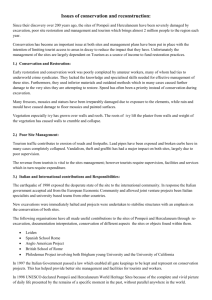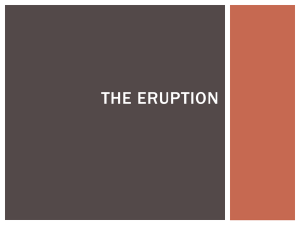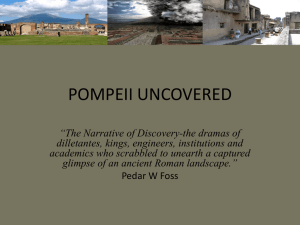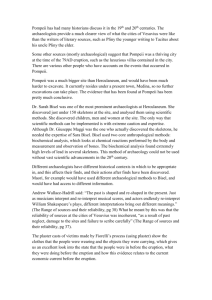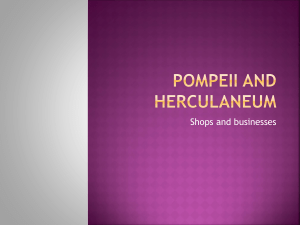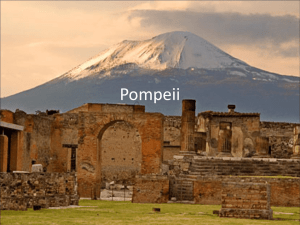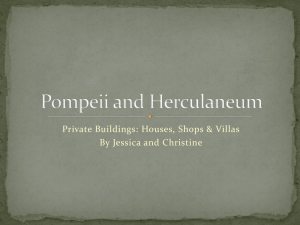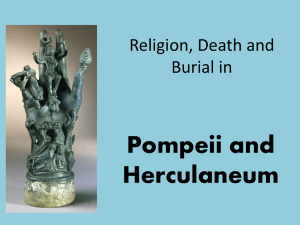2008 Catholic Trial Higher School Certificate Examination
advertisement
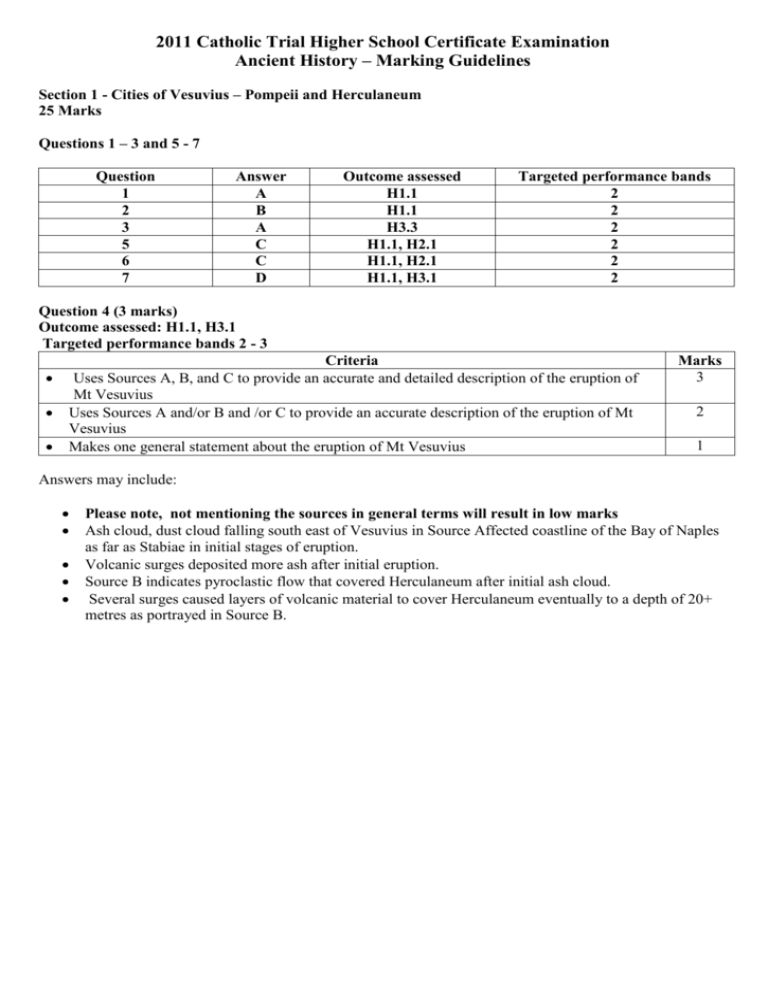
2011 Catholic Trial Higher School Certificate Examination Ancient History – Marking Guidelines Section 1 - Cities of Vesuvius – Pompeii and Herculaneum 25 Marks Questions 1 – 3 and 5 - 7 Question 1 2 3 5 6 7 Answer A B A C C D Outcome assessed H1.1 H1.1 H3.3 H1.1, H2.1 H1.1, H2.1 H1.1, H3.1 Targeted performance bands 2 2 2 2 2 2 Question 4 (3 marks) Outcome assessed: H1.1, H3.1 Targeted performance bands 2 - 3 Criteria Uses Sources A, B, and C to provide an accurate and detailed description of the eruption of Mt Vesuvius Uses Sources A and/or B and /or C to provide an accurate description of the eruption of Mt Vesuvius Makes one general statement about the eruption of Mt Vesuvius Marks 3 2 1 Answers may include: Please note, not mentioning the sources in general terms will result in low marks Ash cloud, dust cloud falling south east of Vesuvius in Source Affected coastline of the Bay of Naples as far as Stabiae in initial stages of eruption. Volcanic surges deposited more ash after initial eruption. Source B indicates pyroclastic flow that covered Herculaneum after initial ash cloud. Several surges caused layers of volcanic material to cover Herculaneum eventually to a depth of 20+ metres as portrayed in Source B. Question 8 (6 marks) Outcomes assessed: H1.1, H3.1, H4.1 Targeted Performance Bands: 2 - 5 Criteria Provides clear, comprehensive and accurate details about the main features of religion in Pompeii and Herculaneum Integrates information from Sources D, E and F about the main features of religion in Pompeii and Herculaneum Provides clear details about some features of religion in Pompeii and/or Herculaneum Makes reference to Sources D and/or E and/or F about religion in Pompeii and/or Herculaneum Provides some information about religion in Pompeii or Herculaneum May refer to the sources provided Makes ONE general point about religion in Pompeii or Herculaneum Marks 5-6 3-4 2 1 Answers may include: Please note, mentioning the sources in general terms with no extra information will result in low marks Extensive evidence of the rituals and participants of the popular cult of Isis have been found in Pompeii. They have been identified due to the extensive number of frescoes taken from the walls of the temple courtyard and displayed in the National Museum of Naples as seen in Source C with a depiction of a priest wearing an Anubis mask. a temple to Isis was constructed with private funds and was one of the first buildings restored after the earthquake of 62 AD. It had a purification room with imported Nile water and a banquet hall. Frescoes depicting the rituals of the goddess and the white robed priests of Isis have been found in Herculaneum Other foreign gods and cults such as Cybele, Osiris (Serapis), Dionysus (Bacchus), Mithras, Sabazius and a host of others were worshipped. The imperial cult was first introduced at the time of Augustus (beginning of the first century AD). This cult was dedicated to the genius or divine aspect of the emperors. Pompeians paid homage to the chief gods of the state, and to the cult of the emperor. Source D is the precinct of the temple of Vespasian, with a sacrificial altar at the foot of the temple where a bull was sacrificed by priests of the cult and prayers were said for the safety of the empire and the emperor. This scene is reproduced on the façade of the altar. The people were not directly involved in the ceremonies although they probably uttered prayers of their own as the rituals were carried out. The temples and sanctuaries in Pompeii and Herculaneum were dedicated to official gods of the state such as the triad of gods – Jupiter, Juno, Minerva Other local gods of Pompeii and Herculaneum were the protector deities, such as Venus, Apollo and Hercules Larariums were small shrines in the houses of Pompeii and Herculaneum, containing small statues and/or painted images of the lares, the household gods who protected the home and family. As Source E indicates, ‘what is more sacred…here are his altars… here are his household gods’ The lararium could contain a statue of the genius, the spirit of the master of the household (paterfamilias) eg The House of the Vetti at Pompeii The family home was the centre of worship, ‘the house of every citizen…so sacred a spot…’ as suggested by Source E Question 9 (10 marks) Outcomes assessed: H1.1, H3.2, H4.1, H4.2 Targeted Performance Bands: 2 - 6 Criteria Provides a clear judgement about Italian and international contributions to conservation and reconstruction in Pompeii and Herculaneum in the last two decades Demonstrates a comprehensive knowledge of the extent of Italian and international contributions to conservation and reconstruction in Pompeii and Herculaneum in the last two decades Integrates information from Sources F and G and own knowledge and uses appropriate historical terms and concepts Makes a judgement about Italian and international contributions to conservation and reconstruction in Pompeii and Herculaneum in the last two decades Demonstrates a knowledge of Italian and international contributions to conservation and reconstruction in Pompeii and Herculaneum in the last two decades Uses information from Sources F and G and own knowledge and uses appropriate historical terms and concepts Attempts a judgement about Italian and international contributions to conservation and reconstruction in Pompeii and Herculaneum in the last two decades Demonstrates a knowledge of some of the Italian and international contributions to conservation and reconstruction in Pompeii and Herculaneum in the last two decades May refer to Sources F and G and own knowledge and uses appropriate historical terms and concepts Describes some of the Italian and international contributions to conservation and reconstruction in Pompeii and Herculaneum in the last two decades May mention Sources F and/or G and uses some terms and concepts Makes ONE or TWO points about the Italian and international contributions to conservation and reconstruction in Pompeii and Herculaneum in the last two decades Marks 9-10 7-8 5-6 3-4 1-2 Answers may include: Please note, not mentioning the sources plus extra information will result in low marks There has been growing support for international cooperation between the Italian government and international organisations and private organisations for the conservation and reconstruction of Pompeii and Herculaneum in the last two decades. In the 1990’s new excavations were halted and stabilisation projects begun to carry out conservation at Pompeii This has created a series of joint ventures between the Italian government and academic institutions, private foundations and corporations such as indicated in Source F and G where Herculaneum is a joint venture between the Herculaneum Conservation project and the Soprintendenza of Pompeii and Herculaneum. The Herculaneum Conservation Project was set up as a collaborative project with the principal objectives of conserving and enhancing the ancient city of Herculaneum. The principal partners are the Packard Institute, the British School at Rome and the Soprintendenza di Pompeii. As Sarah Court says in Source F, ‘a collaboration between the HCP and Fiori’s Special Commission…’ will establish a new project for visitors to walk along the ancient shoreline. This is evident in Source G where restoration and conservation is being conducted on the boatsheds at Herculaneum as mentioned in Source F, ‘these copies will be soon installed in the arches for the public to view’ Institutions from international institutions such as the University of Leiden, The Spanish School at Rome, The British School at Rome, The Anglo – American Project of the University of Bradford, The Pompeii Trust, The Philodemus Project consisting of UCLA, the National Library of Naples and the International centre for the Study of the Herculaneum Papyri are examples of organisations making valuable contributions through re – excavation, documentation, interpretation or conservation of the sites or objects found within them. In 2003 a research project contemplating the architectonical and environmental survey of the Fori Civili of Pompeii has been started off with an American, John Dobbins from the University of Virginia, in charge The Via Dell’ Abbondanza Project has been established to accurately record the building frontages of the structures on the 900 metre-long Via dell’Abbondanza and is being conducted under the auspices of the Soprintendenza di Pompeii. State-of-the-art surveying, photographic and computer equipment are used to create photo mosaics that document the current condition of the structures. New survey techniques are being tried in the Insula Orientalis I block at Herculaneum using 3D laser scanning equipment working with the University of North Carolina. The Soprintendenza of Pompeii and Herculaneum has contributed to conservation efforts of the sites by increased supervision and restrictions on entry to nominated buildings for tour groups. Recent management plans by the authority have introduced rotational access to sections of both sites. Sections of insulae, roads and buildings are closed off to minimize visitor access. In the case of recently-restored monuments such as the House of the Chaste Lovers and the Houses of Polybius and Menander in Pompeii, visits are by reservation only and in small groups, which limits wear.

